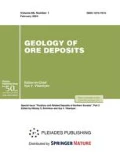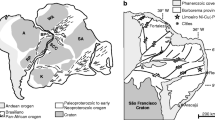Abstract
New data on the composition, assemblages, and formation conditions of platinum-group minerals (PGM) identified in platinum-group element (PGE) occurrences of the Monchetundra intrusion (2495 +- 13 to 2435 ± 11 Ma) are described. This intrusion is a part of the Paleoproterozoic pluton of the Monche-Chuna-Volch’i and Losevy tundras located in the Pechenga-Imandra-Varzuga Rift System. The rhythmically layered host rocks comprise multiple megarhythms juxtaposed to mylonite zones and magmatic breccia and injected by younger intrusive rocks in the process of intense and long magmatic and fluid activity in the Monchetundra Fault Zone.
The primary PGM and later assemblages that formed as a result of replacement of the former have been identified in low-sulfide PGE occurrences. More than 50 minerals and unnamed PGE phases including alloys, Pt and Pd sulfides and bismuthotellurides, PGE sulfarsenides, and minerals of the Pd-As-Sb, Pd-Ni-As, and Pd-Ag-Te systems have been established. The unnamed PGE phases—Ni6Pd2As3, Pd6AgTe4, Cu3Pt, Pd2NiTe2, and (Pd, Cu)9Pb(Te, S)4—are described. The primary PGM were altered due to the effect of several mineral-forming processes that resulted in the formation of micro- and nanograins of Pt and Pd alloys, sulfides, and oxides, as well as in the complex distribution of PGE, Au, and Ag mineral assemblages. New types of complex Pt and Pd oxides with variable Cu and Fe contents were identified in the altered ores. Pt and Pd oxides as products of replacement of secondary Pt-Pd-Cu-Fe alloys occur as zonal and fibrous nanoscale Pt-Pd-Cu-Fe-(±S)-O aggregates.
Similar content being viewed by others
References
T. Auger and O. Legendre, “Platinum-Group-Element Oxides from the Pirogues Ophiolitic Mineralization, New Caledonia: Origin and Significance,” Econ. Geol. 89(7), 1454–1468 (1994).
A. R. Cabral, B. Lehmann, R. Kwitco, et al., “Palladium-Oxygenated Compounds of the Gongo Soco Mine, Quadrilatero Ferrifero, Central Minas Gerais, Brazil,” Mineral. Mag. 65(2), 169–179 (2001).
L. J. Cabri and C. E. Feather, “Platinum-Iron Alloys: A Nomenclature Based on a Study of Natural and Synthetic Alloys,” Can. Mineral. 13(2), 117–126 (1975).
V. V. Chashchin, “Paleoproterozoic Complex of Layered Intrusions of the Kola Peninsula and Its Metallogeny (Russia),” Geol. Rudn. Mestorozhd. 41(2), 3–25 (1999) [Geol. Ore Deposits 41 (2), 114–125 (1999)].
A. V. Dedeev, T. N. Khashkovskaya, and A. S. Galkin, “PGE Mineralization of the Monchegorsk Layered Mafic-Ultramafic Intrusion of the Kola Peninsula,” in The Geology, Geochemistry, Mineralogy and Mineral Beneficiation of Platinum-Group-Elements (Canad. Inst. Mining, Metallurgy and Petroleum, Ottawa, 2002), Special Vol. 54, pp. 569–578.
O. R. Eckstrand, “The Dumont Serpentinite: A Model for Control of Nickeliferous Opaque Mineral Assemblages by Alteration Reactions in Ultramafic Rocks,” Econ. Geol. 70(1), 183–201 (1975).
N. A. Eliseev, E. N. Eliseev, V. K. Kozlov, et al., Geology and Ore Deposits of the Monchegorsk Pluton (Akad. Nauk SSSR, Moscow, 1956), No. 3 [in Russian].
Zh. A. Fedotov and A. V. Mokrushin, “Ultramafic Magmatism of the Monchegorsk Ore Cluster and Metallogeny of Chromium,” in Ore Formation of Precambrian Shields (Kola Sci. Center, Russian Acad. Sci., Apatity, 2008), pp. 141–145 [in Russian].
G. Garuti and F. Zaccarini, “In Situ Alteration of Platinum-Group Minerals at Low Temperature: Evidence from Serpentinized and Weathered Chromitites of the Vourinos Complex, Greece,” Can. Mineral. 34(3), 611–626 (1997).
B. Godel and S.-J. Barnes, “Image Analysis and Composition of Platinum-Group Minerals in the J-M Reef, Stillwater Complex, Montana,” Econ. Geol. 103(3), 637–651 (2008).
T. L. Grokhovskaya, “PGE Mineralization in the Monchegorsk-Monchetundra and Burakovsky Paleoproterozoic Layered Intrusions of the Eastern Baltic Shield,” in Proceedings of the 8th International Platinum Symposium (South African Inst. Mining Metallurgy, Johannesburg, 1998), Ser. 18, pp. 141–143.
T. L. Grokhovskaya and I. P. Laputina, “PGE Mineralization of Some Layered Intrusions in the Kola Peninsula,” in Nickeliferous Mafic-Ultramafic Complexes of the Karelia-Kola Region (Apatity, 1988), pp. 69–73 [in Russian].
T. L. Grokhovskaya, G. F. Bakaev, E. P. Shelepina, M. I. Lapina, I. P. Laputina, and G. N. Muravitskaya, “PGE Mineralization in the Vuruchuaivench Gabbronorite Massif, Monchegorsk Pluton, Kola Peninsula,” Geol. Rudn. Mestorozhd. 42(2), 146–160 (2000) [Geol. Ore Deposits 42 (2), 133–146 (2000)].
T. L. Grokhovskaya, G. F. Bakaev, M. I. Lapina, and V. V. Sholokhnev, “PGE Mineralization of Monchetundra,” in PGE Mineralization and Development of Complex Noble-Metal Deposits (Svyaz-Print, Moscow, 2002), pp. 136–140 [in Russian].
T. L. Grokhovskaya, G. F. Bakaev, V. V. Sholokhnev, M. I. Lapina, G. N. Muravitskaya, and V. S. Voitekhovich, “The PGE Ore Mineralization in the Monchegorsk Igneous Layered Complex (Kola Peninsula, Russia),” Geol. Rudn. Mestorozhd. 45(4), 329–352 (2003) [Geol. Ore Deposits 45 (4), 287–309 (2003)].
T. L. Grokhovskaya, V. V. Distler, S. F. Klyunin, et al., “Low-Sulfide Platinum Group Mineralization of the Lukkulaisvaara Pluton, Northern Karelia,” Intern. Geol. Review 34(5), 503–520 (1992).
J. Jedwab, “Irite (Hermann, 1836/1841) from the Urals,” Mineral. Mag. 68(2), 369–392 (2004).
J. Jedwab, “Oxygenated Platinum-Group-Element and Transition-Metal (Ti, Cr, Mn, Fe, Co, Ni) Compounds in the Supergene Domain,” Chron. Rech. Min., No. 520, 47–53 (1995).
S. Kikuchi, M. Wakeshima, and H. Yu. Yukio, “Electrical Properties of Ternary Metal-Rich Telluride Pd2NiTe2,” J. Ceramic Soc. Japan 117(1), 27–31 (2009).
E. D. Kinloch, “Regional Trends in the Platinum-Group Mineralogy of the Critical Zone of the Bushveld Complex, South Africa,” Econ. Geol. 77(6), 1328–1347 (1982).
V. V. Knauf, A. V. Galkin, and V. A. Dedyukhin, MPG in Taxitic Gabbronorite of the South Framework of NKT (2002), http://www.natiresearch.com.
E. K. Kozlov, B. A. Yudin, and V. S. Dokuchaeva, Mafic and Ultramafic Complexes of the Monche-Volch’ii-Losevy Tundras (Nauka, Leningrad, 1967) [in Russian].
Ch. Li and E. M. Ripley, “Formation of Pt-Fe Alloy by Desulfurization of Pt-Pd Sulfide in the J-M Reef of the Stillwater Complex, Montana,” Can. Mineral. 44(4), 895–903 (2006).
I. McDonald, D. Ohnenstetter, M. Ohnenstetter, and D. G. Vaughan, “Palladium Oxides in Ultramafic Complexes near Lavatrafo, Western Andriamena, Madagascar,” Mineral. Mag. 63(3), 345–352 (1999).
A. M. McDonald, L. J. Cabri, N. S. Rudashevsky, et al., “Nielsenite, a New Platinum-Group Intermetallic Mineral Species from the Skaergaard Intrusion, Greenland,” Can. Mineral. 46(3), 709–716 (2008).
F. Melcher, T. Oberthur, and J. Lodziak, “Modification of Detrital Platinum-Group Minerals from the Eastern Bushveld Complex, South Africa,” Can. Mineral. 43(5), 1711–1734 (2005).
T. Moreno, H. M. Pritchard, R. Lunar, et al., “Formation of a Secondary Platinum-Group Mineral Assemblage in Chromitites from the Herbeira Ultramafic Massif in Cabo Ortegal, NW Spain,” Eur. J. Mineral 11(2), 363–378 (1999).
Yu. N. Neradovsky and E. E. Savchenko, “PGM in Chromite Ore of the Sopcheozero Deposit, Kola Peninsula,” Zap. Ross. Mineral. O-va 137(2), 59–62 (2008) [Geol. Ore Deposits, Zap. Russian Mineral. Soc. 50 (8), 746–748 (2008)].
T. Oberthür, “Platinum-Group-Element Mineralization of the Great Dyke, Zimbabwe,” in The Geology, Geochemistry, Mineralogy and Mineral Beneficiation of Platinum-Group-Elements (Canad. Inst. Mining, Metallurgy, and Petroleum, Ottawa, 2002), Spec. Vol. 54, pp. 483–506.
T. Oberthür and F. Melcher, “Behavior of PGE and PGM in the Supergene Environment: A Case Study of Persistence and Redistribution in the Main Sulphide Zone of the Great Dyke, Zimbabwe,” in Exploration for Platinum-Group-Element Deposits (Mineral. Assoc. Canada Short Course, Ottawa, 2005), Vol. 35, pp. 91–111.
T. Oberthür, F. Melcher, L. Gast, et al., “Detrital Platinum-Group Minerals (PGM) in Rivers of the Eastern Bushveld Complex, South Africa: General Characteristics of the PGM Assemblage,” Can. Mineral. 42(2), 563–582 (2004).
Petrology of Sulfide Magmatic Ore Formation, Ed. by I. D. Ryabchikov (Nauka, Moscow, 1988) [in Russian].
R. Pocha, C. Lohnert, and D. Johrendt, “The Metal-Rich Palladium Chalcogenides (Pd2MCh2) (M=Fe, Co, Ni; Ch=Se, Te): Crystal Structure and Topology of the Electron Density,” J. Solid State Chem. 180(1), 191–197 (2007).
Layered Intrusions of the Monchegorsk Ore District: Petrology, Ore Mineralization, Isotopes, and Deep Structure, Ed. by F. P. Mitrofanov and V. F. Smol’kin (Kola Sci. Center, Russian Acad. Sci., Apatity, 2004) [in Russian].
E. V. Sharkov, Petrology of Layered Intrusions (Nauka, Leningrad, 1980) [in Russian].
V. N. Sokolova, “New Data on the Geology of the Monche-Chuna-Volch’ii Tundras Intrusive Complex (Kola Peninsula),” Sov. Geol., No. 6, 100–111 (1976).
A. V. Tevelev and T. L. Grokhovskaya, “Tectonic Regime of the Formation of Early Proterozoic Layered Plutons of the Baltic Shield,” in Tectonics, Geodynamics and Magmatic and Metamorphic Processes (Geos, Moscow, 1999), Vol. 2, pp. 193–196 [in Russian].
N. D. Tolstykh, A. P. Krivenko, Y. G. Lavrent’ev, et al., “Oxides of the Pd-Sb-Bi System from the Chiney Massif (Aldan Shield, Russia),” Eur. J. Mineral. 12(2), 431–440 (2000).
T. Weiser, “Platinum-Group Minerals (PGM) in Placer Deposits,” in Geology, Geochemistry, Mineralogy and Mineral Beneficiation of Platinum-Group Elements Canadian Inst. Mining, Metallurgy, and Petroleum, Ottawa, 2002), Spec. Vol. 54, pp. 721–756.
Author information
Authors and Affiliations
Corresponding author
Additional information
Original Russian Text © T.L. Grokhovskaya, M.I. Lapina, A.V. Mokhov, 2009, published in Geologiya Rudnykh Mestorozhdenii, 2009, Vol. 51, No. 6, pp. 520–539.
Rights and permissions
About this article
Cite this article
Grokhovskaya, T.L., Lapina, M.I. & Mokhov, A.V. Assemblages and genesis of platinum-group minerals in low-sulfide ores of the monchetundra deposit, Kola Peninsula, Russia. Geol. Ore Deposits 51, 467–485 (2009). https://doi.org/10.1134/S107570150906004X
Received:
Published:
Issue Date:
DOI: https://doi.org/10.1134/S107570150906004X




